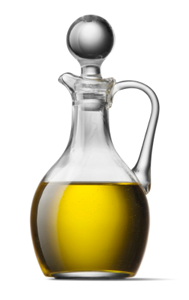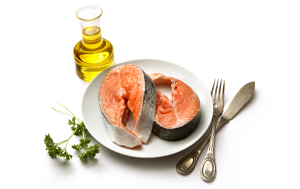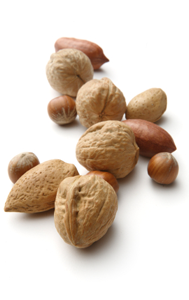Benefits of Fish Oil in Your Diet

Some vegetable oils contain omega 3.
Omega 3 and Heart Health
EPA and DHA are cardioprotective – meaning they are good for the heart. EPA and DHA from fish oil help reduce blood pressure slightly, especially in older individuals who have high blood pressure. In addition, these two fatty acids are tied to a dose-dependent decrease in triglycerides (the fat in your blood), especially in individuals with high triglyceride levels.
In addition to the heart health benefits associated with EPA and DHA, DHA is believed to play a special role in fetal vision and brain development (this is why, several years ago, DHA was added to infant formulas). In addition, studies indicate these two fatty acids may be beneficial for those with major depressive disorder, bipolar disorder and possibly other mood disorders.

Salmon steak
EPA and DHA are primarily found in fatty fish including salmon, tuna, sturgeon, mullet, bluefish, anchovy, sardines, herring, trout, and menhaden. Each of these contains approximately 1 gram of omega-3 fatty acids in about 3.5 ounces of fish. Other sources of EPA and DHA include mackerel, halibut and krill.
How much omega 3 per day?
How much should you consume? Though the government has not set a Dietary Reference Intake (DRI) for EPA and DHA, there is a DRI for alpha linolenic acid (the fatty acid that breaks down into EPA and DHA in the body).
An Adequate Intake (or AI, the recommended average daily nutrient intake) for alpha-linolenic acid is:
- 1.6g/d for adult men
- 1.1g/d for adult women

Walnuts contain some essential fatty acids.
Though ALA does break down to EPA and DHA in the body, this process is very inefficient and affected by other fats you consume. In fact, just 8-21% of the ALA a person consumes is broken down to EPA and even less, just 4-9%, is broken down to DHA (men are on the low end of both of these scales). And, though ALA comes with its own health benefits, it makes sense to reach for EPA and DHA rich foods or supplements, since the majority of the research has focused on these two fatty acids.
Without a government recommendation for EPA and DHA, how do you know how much to consume? The American Heart Association outlines recommendations based on your history of coronary heart disease (CHD). According to their guidelines, those without documented CHD should aim for 3.5 oz cooked (or ¾ cup flaked) fish (particularly fatty fish) at least two times per week.
At the current time, the most well documented benefit of consuming fatty fish or fish oil supplements is the association between EPA, DHA and a reduction in some risk factors for heart disease.
1 Balk E, Chung M, Lichtenstein A, et al. Effects of Omega-3 Fatty Acids on Cardiovascular Risk Factors and Intermediate Markers of Cardiovascular Disease. Summary, Evidence Report/Technology Assessment: Number 93. AHRQ Publication Number 04-E010-1, March 2004. Agency for Healthcare Research and Quality, Rockville, MD. http://www.ahrq.gov/clinic/epcsums/o3cardrisksum.htm
2 Kidd, P.M. (2007). Omega-3 DHA and EPA for cognition, behavior, and mood: clinical findings and structural functional synergies with cell membrane phospholipids. Alternative Medicine Review, 12, 207-227.
3 Fish Oil. Medline Plus, NIH. 2011. http://www.nlm.nih.gov/medlineplus/druginfo/natural/993.html Accessed February 28, 2011.
4 Ulven SM, Kirkhus B, Lamglait A, Basu S, Elind E, Haider T, Berge K, Vik H, Pederson JI. Metabolic effects of krill oil are essentially similar to those of fish oil but at lower dose of EPA and DHA, in healthy volunteers. Lipids 2011; 46(1): 37-46.
5 USDA Interactive DRI for Healthcare Professionals: http://fnic.nal.usda.gov/nal_display/index.php?info_center=4&tax_level=1&tax_subject=621#ai
6 Federal Register Notice of Proposed Rulemaking (Food Labeling) 72 FR 66103 November 27, 2007: Food Labeling: Nutrient Content Claims; Alpha-Linolenic Acid, Eicosapentaenoic Acid, and Docosahexaenoic Acid Omega-3 Fatty Acids http://www.fda.gov/food/labelingnutrition/foodlabelingguidanceregulatoryinformation/regulationsfederalregisterdocuments/
ucm073457.htm
7 Graham, B. (2004). [alpha]-Linolenic acid metabolism in men and women: nutritional and biological implications. Current Opinions in Clinical Nutrition & Metabolism, 7:137-144.
8 Fish and Fish Oil. American Heart Association. http://www.americanheart.org/presenter.jhtml?identifier=4632 Accessed March 3, 2011.
9 Ryan-Harshman, M., and W. Aldoori. (2006). New dietary reference intakes for macronutrients and fibre. Canadian Family Physician, 10, 177-179.

